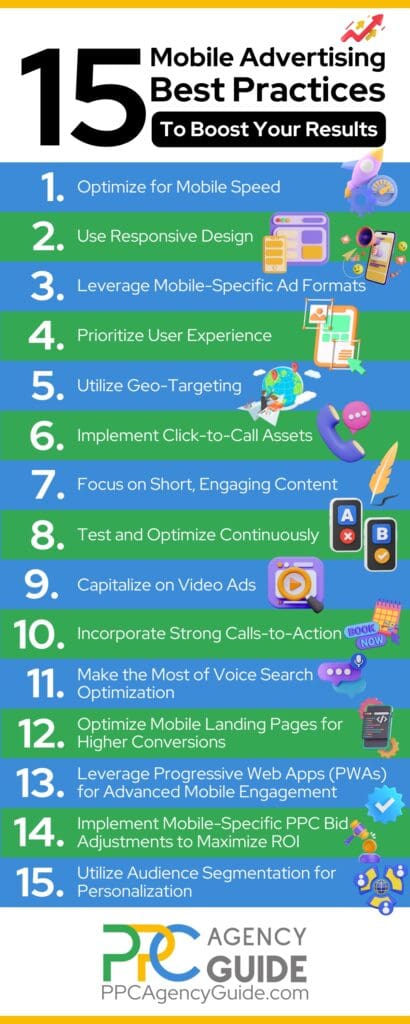
Did you know that over half of all global web traffic now comes from mobile devices? As the world shifts increasingly towards mobile, businesses must pivot their advertising strategies to capture the attention of users on these devices. Mobile advertising isn’t just another channel—it’s becoming the primary way to reach potential customers.
However, placing ads on mobile platforms isn’t enough by itself. To capitalize on the mobile-first world, you need to ensure your pay-per-click (PPC) ads are not only visible but also engaging, relevant, and optimized for the mobile experience. From speeding up load times to leveraging mobile-specific ad formats, every detail counts in turning casual browsers into loyal customers.
In this guide, we’ll walk you through essential mobile advertising best practices to elevate strategy so you can connect with your audience more effectively and boost your results.
Intro to Mobile Advertising
Mobile advertising has become an essential component of any successful marketing strategy. As more people rely on their smartphones and tablets for everyday tasks—whether it’s shopping, staying informed, or connecting with others—businesses must adapt to meet their audience where they are: on mobile devices.
What is Mobile Advertising?
Mobile advertising refers to the practice of delivering promotional content to users on their mobile devices. This can include everything from text ads displayed in search results to interactive videos and in-app banners. The primary goal of mobile advertising is to engage users through their smartphones and tablets, providing them with relevant and timely information that encourages action, whether that’s making a purchase, signing up for a newsletter, or visiting a website.
Why Mobile Advertising Matters
The shift to mobile has been rapid and profound. According to recent statistics, mobile devices now account for over half of all global web traffic, and users spend an average of three hours per day on their mobile devices. This trend shows no signs of slowing down, making mobile advertising a critical area of focus for businesses looking to connect with their target audience effectively.
Mobile Advertising vs. Desktop Advertising
Mobile advertising offers unique advantages over traditional desktop advertising. For one, it allows for more personalized and location-based targeting, which can significantly increase the relevance and impact of your ads. Additionally, mobile ads can take advantage of features unique to smartphones, such as click-to-call functionality and push notifications, to create more seamless and immediate user interactions.
Benefits of Optimizing for Mobile
Optimizing your mobile advertising efforts is a necessity. Nearly 60 percent of online activity now takes place on mobile devices, per Statista. Businesses that fail to optimize their mobile presence risk missing out on significant opportunities for growth and engagement. Let’s take a look at some of the key benefits of focusing on mobile PPC optimization.
Increased Reach and Accessibility
Mobile devices are everywhere, with billions of people around the world using them daily. By optimizing your mobile advertising, you ensure that your content is accessible to the broadest possible audience, anytime and anywhere. This increased reach allows you to connect with potential customers during their most relevant moments—whether they’re commuting, waiting in line, or simply browsing their phone at home.
Improved User Experience
Optimizing for mobile enhances the user experience (UX) by ensuring that your ads and mobile PPC landing pages are tailored to the smaller screens and touch-based interactions of mobile devices. A smooth, responsive experience can reduce bounce rates, increase engagement, and ultimately drive more conversions. Users are more likely to interact with content that loads quickly, displays correctly, and is easy to navigate on their devices.
Higher Engagement Rates
Mobile-optimized ads are more likely to capture users’ attention and encourage interaction. Features like click-to-call, location-based targeting, and mobile-specific ad formats can drive higher engagement rates compared to non-optimized ads. For example, mobile video ads and interactive formats often see better performance metrics, as they align with how users naturally engage with content on their phones.
Enhanced Targeting and Personalization
Mobile devices offer unique opportunities for advanced targeting and personalization. With access to location data, user behavior insights, and device-specific information, you can tailor your ads to meet the specific needs and preferences of your audience. This level of personalization can lead to more relevant and effective mobile PPC campaigns, increasing the likelihood of conversion.
Increased Conversion Rates
When users have a positive experience on mobile, they’re more likely to take action. Whether it’s making a purchase, signing up for a service, or filling out a form, a well-optimized mobile experience can significantly boost conversion rates. By streamlining the path to conversion and minimizing friction, you create a seamless experience that encourages users to complete their journey.
Competitive Advantage
As more businesses recognize the importance of mobile optimization, those that don’t prioritize it risk falling behind. By investing in mobile optimization, you can stay ahead of competitors who may be slower to adapt. A strong mobile presence not only helps you capture more of the market but also positions your brand as modern, user-centric, and in tune with consumer behavior.
Improved Financial Performance
Optimizing for mobile directly impacts your overall return on investment (ROI). By ensuring your mobile campaigns are effective, you’re making the most of every dollar spent, driving higher profitability through increased conversions and better ad performance.
How to Tell if Your Mobile Optimization Needs TLC
To ensure your mobile advertising efforts are effective, it’s essential to track key metrics that can reveal how well your mobile optimization is performing. Here are some critical metrics to monitor.

Mobile Bounce Rate
The mobile bounce rate measures the percentage of users who visit a page on your mobile site and leave without taking any further action, such as clicking to another page. A high bounce rate can indicate that your site isn’t providing a good user experience on mobile. It might suggest issues like slow load times, difficult navigation, or unappealing design.
You can monitor your mobile bounce rate using tools like Google Analytics. Navigate to the Audience > Mobile > Overview section to see bounce rates specifically for mobile users.
Note that a “normal” mobile bounce rate varies by industry, but generally, a bounce rate between 41 percent and 55 percent is average. Rates above this could be a sign that your mobile site needs attention.
Page Load Time
Page load time is the average time it takes for a mobile page to fully load and become interactive for users. Slow page load times can lead to higher bounce rates and lower user engagement, as mobile users tend to have less patience for delays.
Use tools like Google’s PageSpeed Insights to monitor your mobile page load times.
Ideally, your mobile pages should load in under three seconds. Pages that take longer than five seconds to load may lead to a significant drop in user engagement.
Mobile Conversion Rate
Mobile conversion rate refers to the percentage of mobile visitors who complete a desired action, such as making a purchase, filling out a form, or subscribing to a service. A lower mobile conversion rate compared to desktop might indicate that users are encountering obstacles in the mobile conversion process, such as complex forms or poor usability.
You can set up mobile PPC conversion tracking in Google Analytics by creating goals or using e-commerce tracking and filtering results by device category.
Mobile conversion rates can vary widely, but they typically range from one to three percent depending on the industry. If your mobile conversion rate is significantly lower than your desktop rate, it could indicate a problem.
Mobile Search Engine Rankings
Mobile search engine rankings refer to how well your website ranks in search engine results pages (SERPs) when searched from a mobile device. Poor mobile search rankings can reduce your visibility to mobile users, leading to lower traffic and fewer opportunities for conversion.
Use tools like Google Search Console to monitor your site’s performance in mobile search results. Look specifically at the Mobile Usability report and the Performance report filtered by device.
While there isn’t a “normal” ranking position, your mobile rankings should ideally be comparable to your desktop rankings. If your mobile rankings are consistently lower, it suggests a need for mobile optimization.
Cart Abandonment Rate on Mobile
Cart abandonment rate refers to the percentage of users who add items to their cart but leave the site before completing the purchase. High cart abandonment rates on mobile can indicate issues in the checkout process, such as complex forms, slow load times, or limited payment options.
Track this metric in Google Analytics by setting up e-commerce tracking and analyzing the shopping behavior reports filtered by device.
Average cart abandonment rates on mobile sit around 86 percent, compared to 73 percent on desktop, according to Hotjar. If your rate is higher, it may be a sign that your checkout process needs optimization.
Average Session Duration on Mobile
Average session duration measures the average amount of time users spend on your site during a single visit from a mobile device. A short average session duration can suggest that users aren’t finding your content engaging or that your site is difficult to navigate on mobile.
This metric can be viewed in Google Analytics under the Audience > Mobile > Overview section.
Average session duration varies by industry, but for most mobile sites, one to two minutes is considered average. A significantly lower duration could indicate a need for better mobile content or design.
Click-Through Rate on Mobile Ads
Clickthrough rate (CTR) measures the percentage of users who click on your mobile ad after seeing it. A low CTR can indicate that your mobile ads aren’t resonating with your audience, either due to poor PPC mobile targeting, messaging, or ad design.
CTR for mobile ads can be monitored through your ad platform’s reporting tools, such as Google Ads or Facebook Ads Manager.
CTR varies by industry and ad type. For instance, the average CTR text ads on the Google Search Network is 2.27 percent, according to Wordstream. Expanded text ads come in at 3.99 percent, and call-only ads come in at 1.99 percent. A lower CTR might indicate that your ads need to be optimized for mobile.
Mobile-Friendly Test Results
It’s important to think beyond mobile-friendly PPC results and explore your ad experience as a whole. Consider whether your website is optimized for mobile devices, checking for factors like responsive design, touch-friendly elements, and fast loading times. A site that isn’t mobile-friendly can perform poorly in search rankings and provide a subpar user experience, leading to lower engagement and conversion rates.
Google Lighthouse provides an easy way to assess your site’s mobile compatibility. It rates your site from zero to 100. While it’s almost impossible to get a perfect score, anything less than 90 means your website has room to grow.
15 Mobile Advertising Best Practices to Boost Your Results
You now have a solid understanding of what mobile advertising entails and the key metrics that indicate whether your mobile strategy is on track. You’ve seen the crucial role mobile optimization plays in enhancing user experience, boosting engagement, and driving conversions. With this foundation, it’s time to explore the actionable steps you can take and mobile PPC tips to refine your approach and maximize your mobile advertising results.
1. Optimize for Mobile Speed
As mentioned, you only have about three seconds to engage your mobile users before they consider leaving your site, and ensuring that your content loads swiftly and smoothly is crucial to capturing and maintaining their attention. Here’s how to make sure your mobile ads and landing pages meet this critical speed benchmark.
- Streamline Your Code: Minimize unnecessary code, remove redundant scripts, and ensure that your CSS, HTML, and JavaScript are as efficient as possible. Cleaner code translates to faster load times.
- Prioritize Visible Content: Load the content that users see first, such as headlines and key visuals, before anything else. This technique, often called “lazy loading,” ensures that the most important parts of your site are available immediately.
- Optimize Hosting: Choose a hosting provider that offers fast server response times and is optimized for mobile traffic. Consider using a Content Delivery Network (CDN) to distribute your content across multiple servers globally, reducing the distance data must travel to reach your users.
- Leverage Modern Image Formats: Use next-generation image formats like WebP, which offer superior compression and quality compared to traditional formats like JPEG or PNG. This can significantly reduce the size of your images without sacrificing quality.
- Use Mobile-First Design: Design your ads and landing pages with mobile as the primary platform, ensuring that every element is optimized for speed and usability on smaller screens.
By focusing on these practical mobile PPC strategies, you can ensure that your mobile experience is not only fast but also optimized for user engagement from the moment they land on your page.
2. Use Responsive Design
People encounter content on screens that vary widely in size, resolution, and orientation. Responsive design ensures that your mobile ads automatically adjust to fit these varying screen environments, providing a consistent and visually appealing experience across all devices. This adaptability is key to maximizing the effectiveness of your mobile ad campaigns, as it ensures that your message is conveyed clearly, regardless of how or where it’s viewed.

Key Aspects of Responsive Design in Mobile Ads
When implementing responsive design in your mobile ads, focus on the following aspects to ensure your ads are optimized for any screen.
- Flexible Layouts: Design ads that can dynamically resize and rearrange elements based on the screen size and orientation. This ensures that the ad looks good and remains functional whether viewed on a small smartphone in portrait mode or a larger tablet in landscape mode.
- Adaptive Text and Images: Ensure that text, images, and other visual elements scale appropriately. The text should remain legible without needing zooming, and images should resize smoothly to avoid pixelation or cropping that could compromise the ad’s message.
- Device Orientation Considerations: Ads should automatically adjust when a user rotates their device from portrait to landscape mode (or vice versa). This flexibility ensures that your ad maintains its impact and usability no matter how it’s viewed.
- Consistent Branding: Responsive design helps maintain consistent branding across devices. By ensuring that your ads look and feel the same regardless of screen size, you reinforce brand identity and recognition, which can improve overall campaign effectiveness.
3. Leverage Mobile-Specific Ad Formats
Mobile devices offer unique opportunities and challenges compared to desktops. To maximize the effectiveness of your mobile advertising, it’s crucial to leverage ad formats specifically designed for the mobile experience. These formats are optimized to engage users within the context of mobile behavior, taking full advantage of the device’s capabilities and user interaction patterns.
Key Mobile-Specific Ad Formats
When planning your mobile ad campaigns, consider these mobile-specific ad formats that can enhance user engagement and campaign performance
- In-App Ads: Displayed within mobile applications, in-app ads are one of the most effective mobile ad formats. They seamlessly integrate with the app environment, often appearing as banners, interstitials, or native ads. In-app ads typically benefit from higher engagement rates due to their contextually relevant placements within apps that users frequently engage with.
- Mobile Video Ads: Mobile video consumption is on the rise, making video ads a powerful tool for capturing attention. Formats like vertical video ads (designed to be viewed in portrait mode) and short, skippable ads (such as YouTube’s bumper ads) are particularly effective on mobile, where users prefer concise, visually engaging content.
- Interstitial Ads: These full-screen ads appear at natural transition points in an app or mobile site, such as between levels in a game or during page loads. Their full-screen format ensures high visibility, but it’s crucial to use them sparingly to avoid disrupting the user experience.
- Native Ads: Native ads blend seamlessly into the content around them, whether it’s within a social media feed or an article. On mobile, these ads are particularly effective because they don’t feel intrusive and align with the user’s natural scrolling behavior.
- Mobile App Install Ads: Specifically designed to drive app downloads, these ads typically appear in social media feeds or search results, often featuring a direct link to the app store. They’re essential for businesses aiming to grow their mobile app user base.
Benefits of Using Mobile-Specific Ad Formats
Using ad formats tailored for mobile devices helps in a variety of ways.
- Enhance User Engagement: Mobile-specific ad formats are designed to fit seamlessly into the user’s mobile experience, whether they’re using an app, watching a video, or browsing a site. This alignment with user behavior leads to higher engagement rates.
- Maximize Ad Visibility: Formats like interstitial ads or in-app banners are positioned to capture users’ attention without competing with other content, ensuring your message stands out.
- Leverage Device Capabilities: Mobile-specific ad formats can take full advantage of device features like GPS for location-based targeting, cameras for augmented reality experiences, and touchscreens for interactive ads. These capabilities provide richer, more interactive ad experiences that aren’t possible on a desktop.
4. Prioritize User Experience
UX is at the heart of successful mobile advertising. On mobile devices, users are often multitasking, on the move, or interacting with content in brief moments throughout the day. This makes it crucial to design ads that are non-intrusive, user-friendly, and seamlessly integrated into the overall mobile experience. Ads that disrupt the user’s flow or feel intrusive can lead to frustration, higher bounce rates, and negative brand perceptions.
Core Principles of Mobile UX in Advertising
When prioritizing user experience in mobile PPC ads, focus on these key principles.
- Non-Intrusive Ad Placement: Avoid placing ads in a way that interrupts the user’s primary activity. For example, interstitial ads should be used sparingly and only at natural breaks in content, such as between levels in a game or between articles in a news app. Ads that force users to stop what they’re doing or obscure content can lead to a negative experience.
- User-Friendly Design: Mobile ads should be easy to interact with, featuring clear and concise messaging, legible fonts, and buttons that are large enough to tap without difficulty. Complex or cluttered designs can overwhelm users on small screens, leading to frustration and lower engagement.
- Contextual Relevance: Ads should feel relevant to the user’s current activity or environment. For example, an ad for a fitness app might perform better when shown within a health-related app or content. Contextual relevance enhances the ad’s value to the user and increases the likelihood of positive engagement.
- Seamless Integration: Design ads that blend naturally with the surrounding content. Native ads, for instance, are effective because they match the look and feel of the platform they appear on, whether it’s a social media feed or a news site. This seamless integration reduces the likelihood of user disruption and enhances the overall experience.
- Avoiding Intrusive Formats: While some ad formats like pop-ups or auto-playing videos might capture attention, they can also be highly disruptive on mobile devices. Prioritize formats that allow users to engage with the ad at their own pace, such as scrollable banners or in-feed native ads.
Benefits of Prioritizing UX in Mobile Ads
Focusing on UX offers many benefits.
- Enhance Brand Perception: Ads that respect the user’s experience contribute to a positive brand image. Users are more likely to appreciate and remember brands that don’t intrude on their mobile activities.
- Increase Engagement: User-friendly ads that are easy to interact with and contextually relevant are more likely to result in clicks, conversions, and overall positive engagement.
- Reduce Ad Fatigue: Non-intrusive, well-integrated ads reduce the risk of ad fatigue, where users become frustrated or disengaged due to overexposure to annoying or repetitive ads.
5. Utilize Geo-Targeting
Geo-targeting allows you to deliver ads to users based on their geographic location, enabling you to create more personalized and contextually relevant ad experiences. With mobile devices, geo-targeting becomes especially powerful because smartphones and tablets are often equipped with GPS, enabling highly accurate location data. This allows you to tailor your advertising efforts to specific regions, cities, or even neighborhoods, ensuring that your message reaches the right audience at the right place and time.

Key Benefits of Geo-Targeting
Leveraging geo-targeting in your PPC for mobile devices offers several distinct advantages.
- Increased Relevance: Ads that are tailored to a user’s location are inherently more relevant. For example, promoting a local store, event, or service is far more effective when the ad is shown to users in the vicinity. This relevance can lead to higher engagement rates and better conversion outcomes.
- Timely Messaging: Geo-targeting enables you to deliver time-sensitive messages based on the user’s location. For instance, a restaurant could use geo-targeting to promote lunch specials to users who are nearby during lunchtime, increasing the likelihood of driving foot traffic.
- Efficient Ad Spend: By focusing your ad spend on specific locations where your target audience is most concentrated, you can maximize the efficiency of your budget. This precision targeting reduces waste and ensures that your ads are reaching the people who are most likely to be interested in your offerings.
- Localized Promotions: Geo-targeting allows you to run local mobile PPC campaigns that resonate with specific communities. For example, a national retailer could promote different products or offers in different regions based on local preferences or events.
Best Practices for Effective Geo-Targeting
To get the most out of geo-targeting in your mobile ad campaigns, consider the following best practices.
- Leverage Location Data: Use the detailed location data available from mobile devices to target users in specific areas. This can range from broad regional targeting to hyper-local targeting, such as within a certain radius of your business.
- Tailor Ad Content to Location: Customize your mobile PPC ad copy, visuals, and offers to align with the targeted location. For example, an ad shown in a coastal city might highlight beachwear, while one in a colder region might promote winter gear.
- Combine Geo-Targeting with Behavioral Data: Enhance your targeting by combining location data with behavioral insights. For example, you could target users who frequently visit coffee shops within a specific area with ads for a new coffee brand.
- Monitor and Adjust: Continuously monitor the performance of your geo-targeted campaigns and adjust your targeting criteria as needed. This ensures that your ads remain relevant and effective as user behaviors and locations change over time.
6. Implement Click-to-Call Assets
For many businesses, especially those that rely on direct customer interactions, getting potential customers to make a phone call can be a crucial step in the conversion process. Mobile ad extensions, now known as “assets,” in PPC, help. Click-to-call assets, for example, make it easy for mobile users to connect with your business directly from your ad with just a single tap. This feature is particularly powerful in mobile advertising because it capitalizes on the immediate nature of mobile interactions, allowing users to quickly and conveniently reach out to your business.
Key Benefits of Click-to-Call Assets
Adding click-to-call assets to your mobile ads offers several significant advantages.
- Direct Engagement: Click-to-call allows users to bypass additional steps and engage with your business directly. This direct line of communication can lead to higher conversion rates, particularly for businesses where phone calls are a primary method of closing sales or answering customer inquiries.
- Convenience for Users: Mobile users are often on the go and may not have the time or patience to fill out a form or browse a website. Click-to-call provides a convenient way for them to take immediate action, whether it’s making a reservation, inquiring about a product, or booking a service.
- Enhanced Ad Performance: Ads with click-to-call assets can perform better because they offer a clear, actionable next step. This can lead to higher CTRs and improved overall ad effectiveness.
- Measurable Results: Click-to-call assets allow you to track call conversions, giving you valuable insights into how your ads are driving direct engagement. This data can help you refine your campaigns and optimize for better results.
Best Practices for Implementing Click-to-Call Assets
To maximize the effectiveness of click-to-call in your mobile ads, consider the following best practices
- Use Compelling Call-to-Actions: Your call-to-action (CTA) should clearly communicate the benefit of calling. Phrases like “Call Now for a Free Quote” or “Speak to an Expert Today” can encourage users to take immediate action.
- Set Up Call Tracking: Implement call tracking to measure the success of your click-to-call assets. This will allow you to see which ads are driving the most calls and make data-driven decisions to optimize your campaigns.
- Optimize for Local Searches: If your business operates in specific locations, combine click-to-call assets with geo-targeting to reach users who are nearby and more likely to need immediate assistance or services.
- Test Different Call Times: Consider the times when your audience is most likely to make calls and schedule your click-to-call ads accordingly. This can help you capture more leads during peak call times.
7. Focus on Short, Engaging Content
Users often interact with content while multitasking or during brief moments of downtime, meaning they have little patience for long-winded or complex messaging. To capture and hold the attention of mobile users, your content must be both concise and compelling. Focusing on short, engaging content is essential for maximizing the effectiveness of your mobile ads.
Key Principles for Creating Short, Engaging Mobile Content
When crafting content for mobile ads, prioritize the following principles to ensure your message resonates quickly and effectively.
- Clear and Direct Messaging: Get straight to the point. Your ad should communicate its core message within the first few words or seconds. Avoid unnecessary fluff, and focus on what’s most important to your audience—whether it’s a unique value proposition, a special offer, or a compelling call-to-action.
- Strong Visuals: Pair your concise message with eye-catching visuals that reinforce your content. Visuals are processed faster than text and can help convey your message at a glance. Use high-quality images, bold graphics, or short videos that grab attention and enhance your message.
- Compelling Calls-to-Action: Your CTA should be clear, concise, and action-oriented. Whether it’s “Shop Now,” “Learn More,” or “Get Started,” make sure your CTA encourages users to take the next step without hesitation.
- Use of Emojis and Symbols: On mobile, where space is limited, emojis and symbols can be effective tools for conveying emotions or ideas quickly. However, use them sparingly and ensure they align with your brand’s tone and message.
- Engaging Headlines and Hooks: The headline or opening line of your ad is crucial for grabbing attention. Craft headlines that spark curiosity, offer value, or address a pain point directly. This will encourage users to engage further with your content.
Benefits of Short, Engaging Content in Mobile Ads
Tailoring your copy for the mobile experience offers a wealth of benefits.
- Increase User Engagement: Short, to-the-point content is easier for users to digest, making them more likely to engage with your ad. This can lead to higher click-through rates (CTR) and improved overall ad performance.
- Enhance Recall: Messages that are clear and succinct are easier for users to remember, increasing the likelihood that they’ll think of your brand when they’re ready to make a purchase.
- Improve Load Times: Shorter content often means lighter files, which can contribute to faster load times—a critical factor for maintaining user attention on mobile devices.
8. Test and Optimize Continuously
The digital landscape is constantly evolving, and so are user behaviors and preferences. What works today may not be as effective tomorrow, which is why continuous testing and optimization are essential components of a successful mobile advertising strategy. By regularly testing different elements of your ads and making data-driven adjustments, you can ensure that your campaigns remain effective and continue to deliver optimal results.

Essential Areas to Test and Optimize
When it comes to mobile advertising, several elements should be tested and optimized on an ongoing basis.
- Ad Creative: Regularly test different versions of your ad creative, including images, videos, headlines, and copy. A/B testing allows you to compare variations and determine which resonates most with your audience. For example, you might test different headlines to see which generates the highest CTR.
- Targeting Parameters: Continuously refine your targeting parameters to ensure your ads reach the most relevant audience. This might involve adjusting demographic targeting, testing different geographic locations, or experimenting with various audience segments based on interests or behaviors.
- Ad Formats: Different ad formats may perform better depending on your audience and goals. Test various mobile-specific formats, such as native ads, video ads, or interstitials, to see which delivers the best results in terms of engagement and conversions.
- Bidding Strategies: Experiment with different bidding strategies to optimize your ad spend. Whether it’s manual bidding, automated bidding, or enhanced CPC (cost-per-click), testing these approaches can help you maximize ROI by ensuring you’re getting the most value for your budget.
- Landing Pages: While this section focuses on ads, it’s important to recognize the role of landing pages in the overall conversion process. Ensure that the landing pages your ads lead to are optimized for mobile, load quickly, and align with the ad’s messaging. Test different layouts, CTAs, and content to see what drives the highest conversion rates.
Benefits of Continuous Testing and Optimization
Regular testing and optimization offer several important benefits for your mobile advertising campaigns.
- Improved Performance: By identifying and implementing the most effective elements of your ads, you can continuously improve campaign performance, leading to higher engagement rates, better CTRs, and more conversions.
- Data-Driven Decisions: Continuous testing provides you with valuable data that can inform your decisions, allowing you to move away from guesswork and toward strategies that are proven to work.
- Adaptability to Market Changes: The digital market is dynamic, with user preferences and behaviors changing over time. Continuous optimization ensures that your ads stay relevant and effective, even as market conditions shift.
- Maximized ROI: By consistently refining your approach, you can make the most of your advertising budget, ensuring that each dollar spent is driving the best possible results.
9. Capitalize on Video Ads
Video content has become a dominant force in digital marketing, particularly on mobile devices, where users increasingly consume video content throughout the day. Video ads offer a dynamic and engaging way to capture attention, convey your message, and drive conversions. With the rise of platforms like YouTube, Instagram, and TikTok, video ads have become an essential tool for reaching mobile audiences.
Top Advantages of Video Ads on Mobile
Utilizing video ads in your mobile advertising strategy offers several significant benefits.
- High Engagement Rates: Video ads are inherently more engaging than static images or text. The combination of visuals, audio, and movement captures users’ attention quickly and can convey complex messages in a short amount of time. This makes video ads particularly effective on mobile, where users are often scrolling quickly through content.
- Storytelling Power: Video ads allow you to tell a story, evoke emotions, and build a narrative around your brand or product. This storytelling capability can create a deeper connection with your audience and increase the likelihood of them taking action.
- Increased Reach and Visibility: Platforms that prioritize video content, like YouTube and Instagram, offer significant reach for video ads. Additionally, many social media platforms automatically play videos as users scroll, increasing the likelihood that your ad will be seen.
- Adaptability Across Formats: Video ads can be tailored to fit various formats, including short-form videos for social media, in-stream ads on video platforms, and vertical videos optimized for mobile screens. This adaptability allows you to reach your audience in the most effective way possible, depending on the platform and context.
Best Practices for Effective Mobile Video Ads
To maximize the impact of your video ads on mobile devices, consider the following best practices.
- Keep it Short and Sweet: Mobile users typically have shorter attention spans, so it’s important to keep your video ads concise. Aim for videos that are 15 seconds or less to ensure your message is delivered before users lose interest.
- Capture Attention Early: The first few seconds of your video are crucial. Start with a strong hook—whether it’s an eye-catching visual, a provocative question, or a surprising statement—to grab the viewer’s attention right away.
- Design for Sound-Off Viewing: Many mobile users watch videos without sound, so it’s important to ensure your message is clear even if the audio is muted. Use captions, on-screen text, and strong visuals to communicate your key points.
- Optimize for Vertical Viewing: With the majority of mobile users holding their phones vertically, creating vertical or square videos ensures that your ads take up more screen space and are easier to view without requiring users to rotate their devices.
- Include a Clear CTA: Just like with any other ad format, your video ad should include a strong call-to-action (CTA). Whether it’s “Shop Now,” “Learn More,” or “Download the App,” make sure viewers know what action you want them to take after watching the video.
10. Incorporate Strong Calls-to-Action
While we’ve brought up CTAs a few times already, they’re deserving of their own spot on this list, too. CTAs are the crucial bridge between capturing a user’s attention and converting that interest into action. Whether it’s encouraging a click, a call, or a purchase, a well-crafted CTA can significantly boost the effectiveness of your mobile ads.
Best Practices for Creating Effective CTAs on Mobile
Let’s take a look at how to refine and enhance your CTAs specifically for mobile ads.
- Be Direct and Action-Oriented: The best CTAs are clear and tell the user exactly what to do. Phrases like “Shop Now,” “Get Started,” “Call Today,” or “Download the App” remove any ambiguity, making it easy for users to understand what action is required.
- Make CTAs Visually Prominent: On mobile screens, where space is limited, it’s important to ensure that your CTA stands out. Use contrasting colors, bold fonts, or buttons to make your CTA pop. The user’s eye should naturally be drawn to the CTA without it feeling forced or disruptive.
- Align CTAs with User Intent: Your CTA should match the intent of the user at the moment they see the ad. For example, if your ad is promoting a limited-time offer, “Claim Your Discount” could be a compelling CTA. If the user is in the research phase, “Learn More” might be more appropriate.
- Positioning Matters: Place your CTA where it’s easily accessible, especially considering that users typically interact with mobile devices using their thumbs. Ensure the CTA is within the “thumb zone” and doesn’t require unnecessary scrolling or tapping to reach.
- Create a Sense of Urgency: Urgency can be a powerful motivator in CTAs. Phrases like “Limited Time Offer,” “Act Now,” or “Only X Left” can encourage users to act immediately rather than putting it off and potentially forgetting.
- Test and Optimize CTAs: Just as with other elements of your mobile ads, continuously test different versions of your CTAs to see which ones resonate most with your audience. Small changes in wording, color, or placement can have a significant impact on performance.
11. Make the Most of Voice Search Optimization
With the increasing use of voice-activated assistants like Siri, Google Assistant, and Alexa, voice search is becoming a crucial aspect of mobile user behavior. This trend has significant implications for mobile advertising, particularly in how ads are designed and targeted. Optimizing your mobile ads for voice search can help you capture a growing segment of users who prefer using voice commands to find products, services, or information on the go.

How Voice Search Affects Mobile Advertising
Voice search changes the way users interact with content and ads on their mobile devices. Instead of typing keywords into a search bar, users ask questions or make requests in a conversational tone. This shift means that ads must be adapted to align with these natural language queries, focusing on intent and relevance to the user’s immediate needs.
Strategies for Voice Search Optimization in Mobile Ads
To capitalize on the rise of voice search in mobile advertising, consider these strategies.
- Tailor Ad Copy to Natural Language: Voice searches tend to be more conversational, so your ad copy should reflect this. Use phrases and questions that people are likely to speak rather than type. For example, instead of “best Italian restaurant,” consider “Where’s the best Italian restaurant near me?”
- Focus on Local Intent: Many voice searches are location-based, with users looking for nearby services or products. Ensure your mobile ads are optimized for local intent by using location-specific keywords and targeting options. This can help your ads appear in response to voice searches like “Find a coffee shop near me.”
- Leverage Conversational CTAs: Just as voice search queries are more conversational, your calls-to-action (CTAs) should also reflect this tone. Consider using CTAs that mimic spoken language, such as “Call us now” or “Get directions.”
- Optimize for Voice-Activated Assistants: Some mobile ads may appear as suggestions or results from voice-activated assistants. Ensure that your ads are structured in a way that these assistants can easily pull relevant information, increasing the chances of your ad being presented as a solution to a user’s query.
Benefits of Voice Search Optimization in Mobile Advertising
By optimizing your mobile ads for voice search, you can:
- Capture a Growing Audience: As voice search becomes more popular, especially on mobile devices, optimizing your ads for this format helps you reach a broader audience.
- Enhance Relevance and Engagement: Ads that align with natural language queries are more likely to resonate with users, leading to higher engagement and better ad performance.
- Improve Local Ad Performance: Given the local nature of many voice searches, optimizing for these queries can boost the effectiveness of your location-based mobile ads.
12. Optimize Mobile Landing Pages for Higher Conversions
A well-optimized mobile landing page is critical to converting visitors into customers. Once a user clicks on your mobile ad, the landing page is where the conversion happens—or doesn’t. Even the most effective ads can fall flat if the landing page they lead to isn’t optimized for mobile users. Ensuring that your landing pages are designed and structured specifically for mobile devices can significantly improve your conversion rates.
Key Elements of a High-Converting Mobile Landing Page
To maximize conversions on your mobile landing pages, focus on these essential elements.
- Responsive and Fast-Loading Design: Your landing page must be responsive, meaning it adapts seamlessly to any screen size, and it should load quickly to avoid losing impatient users. Mobile users expect pages to load in under three seconds—anything longer can lead to high bounce rates. Ensure your design is not only visually appealing but also optimized for speed.
- Simplified Navigation: On mobile devices, navigation should be as simple as possible. Reduce the number of menu items, avoid pop-ups, and eliminate unnecessary distractions. The user should be able to focus solely on the content and the action you want them to take.
- Clear and Concise Content: Mobile screens offer limited space, so it’s important to keep your content clear, concise, and focused. Use short paragraphs, bullet points, and direct language to communicate your message effectively. Make sure that the most important information is front and center.
- Prominent and Actionable CTAs: Your CTA should be immediately visible and easy to tap on a mobile device. Use contrasting colors, large buttons, and clear, action-oriented language. Consider placing the CTA above the fold (visible without scrolling) so users can act without having to search for it.
- Visual Hierarchy and Design: Create a visual hierarchy that guides the user’s eye to the most important elements of the page, such as the headline, key benefits, and CTA. Use bold text, contrasting colors, and strategic placement to make these elements stand out. Remember that simplicity is key—avoid cluttering the page with too many competing visuals or text blocks.
- Mobile-Friendly Forms: If your landing page includes a form, ensure it’s optimized for mobile users. Keep the form short, asking only for essential information, and use large, easy-to-tap fields. Implement features like autofill and drop-down menus to make the process as seamless as possible.
- Trust Signals: Include trust signals like customer testimonials, reviews, security badges, or certifications to build credibility and reassure users that taking the desired action is safe and beneficial. These elements are particularly important on mobile, where users may be more cautious about entering personal information
Benefits of Optimizing Mobile Landing Pages
By optimizing your mobile landing pages, you can:
- Increase Conversion Rates: A well-designed mobile landing page reduces friction and makes it easy for users to complete the desired action, whether it’s making a purchase, filling out a form, or signing up for a service.
- Enhance User Experience: A smooth, intuitive experience on your landing page keeps users engaged and reduces the likelihood of them abandoning the process halfway.
- Maximize ROI on Ad Spend: Optimized landing pages ensure that the traffic you drive from is more likely to convert, increasing mobile PPC ROI and making your ad spend more efficient.
13. Leverage Progressive Web Apps (PWAs) for Advanced Mobile Engagement
Progressive Web Apps (PWAs) are a powerful tool for enhancing user engagement on mobile devices. PWAs combine the best features of both websites and native mobile apps, offering a seamless, app-like experience directly through the browser without requiring users to download anything from an app store. For advertisers, PWAs provide a unique opportunity to create immersive, responsive, and highly engaging mobile experiences that can significantly boost user interaction and conversion rates.
Top Benefits of Using PWAs in Mobile Advertising
PWAs offer several advantages that can enhance your mobile advertising strategy.
- Fast and Reliable Performance: PWAs are designed to load quickly, even in areas with poor network coverage. This ensures that users have a smooth and consistent experience, which is crucial for retaining engagement and reducing bounce rates.
- App-Like Experience: PWAs offer an experience that closely mimics that of a native app, including features like push notifications, offline access, and the ability to add the app to the home screen. This app-like functionality can deepen user engagement and encourage repeat visits.
- Cross-Platform Compatibility: Unlike native apps, which need to be developed separately for different operating systems (iOS, Android), PWAs work across all devices and browsers. This broad compatibility ensures that your mobile content is accessible to the widest possible audience.
- Reduced Friction in User Interaction: Since PWAs don’t require an app store download, users can access your content more easily, reducing the friction that typically comes with getting users to engage with a native app. This ease of access can lead to higher engagement and conversion rates.
How to Leverage PWAs in Your Mobile Advertising Strategy
To effectively use PWAs for advanced mobile engagement, consider these strategies.
- Create Engaging, Interactive Content: Use the advanced capabilities of PWAs to offer interactive content, such as quizzes, personalized recommendations, or gamified experiences, directly within the app. This level of interactivity can increase user dwell time and encourage deeper engagement with your brand.
- Incorporate Push Notifications: One of the key features of PWAs is the ability to send push notifications, similar to native apps. Use these notifications to re-engage users with personalized offers, reminders, or updates, driving them back to your PWA even after they’ve left.
- Optimize for Offline Access: PWAs can be designed to work offline or with limited connectivity, making them particularly useful for users in areas with spotty mobile service. By ensuring that key content remains accessible offline, you can maintain user engagement regardless of their network status.
- Use PWAs for Retargeting Campaigns: Leverage PWAs in your retargeting efforts by directing users to a PWA after they’ve interacted with your ads. The enhanced functionality and app-like experience of a PWA can help you convert users who may not have taken action on their initial visit.
14. Implement Mobile-Specific PPC Bid Adjustments to Maximize ROI
In pay-per-click (PPC) advertising, not all clicks are created equal—especially when comparing mobile to desktop traffic. Mobile users often exhibit different behaviors, intents, and conversion patterns compared to desktop users. Implementing mobile-specific PPC bid adjustments allows you to fine-tune your bids based on the performance and value of mobile traffic, ensuring that you’re maximizing your return on investment (ROI) for mobile ads.

Why Mobile-Specific Bid Adjustments Matter
By adjusting your bids specifically for mobile devices, you can:
- Optimize Budget Allocation: Mobile PPC bid adjustments help you allocate your budget more effectively by increasing or decreasing bids based on the performance of your ads on mobile devices. If mobile users are more likely to convert or engage with your ads, you can increase your bids to capture more of that high-value traffic.
- Improve Ad Positioning: Higher bids on mobile can improve your ad’s position in mobile search results or on mobile apps, making it more likely that users will see and click on your ad. This is particularly important in competitive markets where visibility is key to driving conversions.
- Enhance Targeting Precision: Mobile bid adjustments allow you to target mobile users more precisely, ensuring that your ads reach the right audience at the right time. For example, you might increase bids for mobile users searching for immediate, location-based services or products.
- Maximize ROI: By optimizing your bids for mobile, you can achieve a better ROI by focusing your spend on the devices that deliver the best results. This means getting more conversions and value out of your ad spend.
How to Implement Mobile-Specific PPC Bid Adjustments
To effectively implement mobile-specific bid adjustments in your PPC campaigns, follow these steps
- Analyze Performance Data: Start by reviewing your campaign performance data to understand how mobile traffic compares to desktop. Look at key metrics such as click-through rates (CTR), conversion rates, and cost-per-conversion for mobile users. This data will inform your bid adjustment strategy.
- Set Mobile Bid Adjustments: Based on your analysis, adjust your bids for mobile devices. If mobile users are converting at a higher rate, consider increasing your bids by a certain percentage to capture more of this valuable traffic. Conversely, if mobile performance is lower, you might decrease your bids to reduce spend on less effective clicks.
- Use Automated Bidding Strategies: Many PPC platforms, including Google Ads, offer automated bidding strategies that can optimize bids in real-time based on device performance. These strategies use machine learning to adjust bids dynamically, ensuring you’re maximizing ROI without manual intervention.
- Monitor and Refine: Continuously monitor the performance of your mobile bid adjustments and refine them as needed. The effectiveness of your bids can change over time due to factors like seasonality, competition, and changes in user behavior. Regularly reviewing and adjusting your bid strategy ensures sustained ROI.
15. Utilize Audience Segmentation for Personalization
Personalization is key to capturing the attention of your target audience. Audience segmentation allows you to divide your broader audience into smaller, more specific groups based on characteristics such as demographics, behavior, interests, and more. By tailoring your mobile ads to these segments, you can deliver highly relevant and personalized content that resonates with users, leading to higher engagement and conversion rates.
Why Audience Segmentation Matters
Mobile users expect content that speaks directly to their needs and preferences. Generic, one-size-fits-all ads are less likely to capture attention or drive action. By utilizing audience segmentation, you can:
- Increase Relevance: Segmented ads are more relevant to the user, as they are tailored to specific groups based on their behaviors, preferences, and demographics. This relevance makes users more likely to engage with your ads and take the desired action.
- Enhance User Experience: Personalization through segmentation improves the overall user experience by providing content that feels custom-made for the user. This can lead to stronger brand loyalty and a higher likelihood of repeat engagements.
- Boost Conversion Rates: Ads that are aligned with the specific needs and desires of a segmented audience are more likely to convert. Whether you’re targeting first-time visitors, repeat customers or high-value prospects, segmentation helps you deliver the right message at the right time.
- Maximize Ad Spend Efficiency: By focusing your budget on specific segments that are more likely to convert, you can reduce waste and improve the efficiency of your ad spend. This means more impactful ads and better overall ROI.
How to Implement Audience Segmentation in Mobile Advertising
To effectively utilize audience segmentation for personalization in your mobile ads, consider these strategies:
- Identify Key Segments: Start by identifying the most important segments of your audience. This could be based on factors such as age, gender, location, purchasing behavior, device type, or engagement level. The more detailed your segmentation, the more personalized your ads can be.
- Tailor Ad Content to Each Segment: Once you’ve identified your segments, create ad content that speaks directly to each group. For example, if you’re targeting young professionals, you might emphasize convenience and time-saving benefits, while ads for retirees might focus on comfort and ease of use.
- Use Dynamic Content: Dynamic ad content allows you to automatically tailor elements of your ad (such as text, images, or offers) based on the segment. This ensures that each user sees the version of the ad that is most relevant to them, increasing the likelihood of engagement.
- Leverage Data and Insights: Use data from previous campaigns and audience insights to refine your segments and improve targeting. The more you know about your audience, the better you can tailor your ads to meet their specific needs and preferences.
- Test and Optimize: Continuously test different segmentation strategies and ad variations to see what resonates most with each group. Use this data to optimize your campaigns and improve performance over time.
Get Help Weaving Mobile Advertising Best Practices into Your Campaigns
As you can see, a lot goes into applying these best practices for mobile PPC campaigns. However, it’s a process that can pay off big time in terms of ROI and sales. If you’d like to start attracting and converting more mobile users, request a complimentary consultation.

FAQs on Mobile Advertising Best Practices
How can I optimize my mobile ads for better engagement?
Knowing how to optimize mobile PPC ads for better engagement is critical to success. Focus on creating concise, visually appealing content that captures attention quickly. Use responsive design to ensure ads display correctly on all devices and formats. Leverage geo-targeting and audience segmentation to deliver relevant ads to the right users. Incorporate clear, actionable CTAs, and consider using video ads for higher engagement. Regularly test different ad variations and optimize based on performance data to continually improve results.
Why is responsive design important for mobile advertising?
Responsive design is crucial for mobile advertising because it ensures that your ads automatically adjust to different screen sizes and orientations, providing a seamless experience across all devices. This adaptability helps maintain the visual appeal and functionality of your ads, regardless of the user’s device, leading to better engagement and higher conversion rates. Responsive design also improves user experience by making your ads easier to interact with on mobile devices.
How do mobile-specific PPC bid adjustments improve ROI?
Mobile-specific PPC bid adjustments allow you to optimize your ad spend by increasing or decreasing bids based on the performance of mobile traffic. By focusing more of your budget on high-performing mobile segments, you can improve ad visibility, capture more valuable clicks, and drive better conversion rates. This targeted approach helps maximize ROI by ensuring that your advertising dollars are spent where they’re most effective, particularly on devices where users are more likely to engage and convert.
What is the impact of voice search on mobile advertising?
Voice search is changing the way users interact with content on mobile devices, favoring conversational queries and immediate answers. Optimizing mobile ads for voice search involves tailoring ad copy to natural language phrases, focusing on local intent, and creating CTAs that align with spoken queries. By adapting to these mobile PPC trends, you can increase the relevance and effectiveness of your ads, capturing a growing segment of voice search users who are often looking for quick, actionable information.
How do Progressive Web Apps (PWAs) enhance mobile user engagement?
PWAs enhance mobile user engagement by offering an app-like experience directly through the browser, without requiring a download. They load quickly, work offline, and provide features like push notifications and home screen icons. This seamless, responsive experience encourages users to interact more deeply with your content, leading to higher engagement and conversions. PWAs also work across all devices and browsers, making them an effective tool for reaching a broad mobile audience.
Why is it important to test and optimize mobile ads continuously?
Continuous testing and optimization are vital for mobile ads because user behaviors and preferences can change rapidly. By regularly testing different ad elements—such as creative, targeting, and bids—you can identify what works best and adjust your strategy accordingly. This ongoing optimization helps improve ad performance, increase engagement, and ensure that your mobile advertising remains effective over time, ultimately leading to better ROI.
What are some effective mobile-specific ad formats?
Effective mobile-specific ad formats include in-app ads, mobile video ads, interstitial ads, native ads, and mobile app install ads. Each format is designed to take advantage of mobile devices’ unique features, such as touchscreens and location services. These formats are optimized for the mobile experience, making them more engaging and effective at capturing user attention and driving conversions compared to traditional ad formats.
How can I use geo-targeting in mobile ads to increase relevance?
Geo-targeting allows you to deliver ads to users based on their geographic location, making your ads more relevant to their immediate context. By using geo-targeting, you can promote location-specific offers, drive foot traffic to nearby stores, or target users with local services. This increases the likelihood of engagement and conversion, as users are more likely to interact with ads that are relevant to their current location and needs.
How does audience segmentation improve the effectiveness of mobile advertising?
Audience segmentation improves mobile advertising by allowing you to tailor ads to specific groups based on demographics, behavior, and interests. This personalization ensures that users see content that resonates with them, leading to higher engagement and conversion rates. By focusing on the needs and preferences of different segments, you can create more relevant and impactful ads, ultimately driving better results and maximizing your return on investment.
How does mobile PPC keyword research differ from traditional keyword research?
While traditional keyword research focuses on identifying keywords for all devices, mobile PPC keyword research specifically targets the search behavior of mobile users. This includes considering factors like shorter search phrases, voice search, and the increasing use of location-based queries. Optimizing for these mobile-specific keywords can significantly enhance the effectiveness of your PPC campaigns on mobile devices.


















